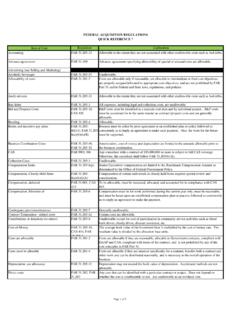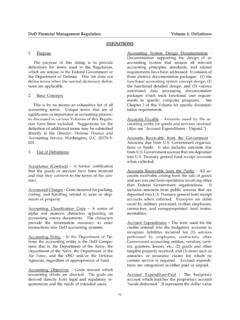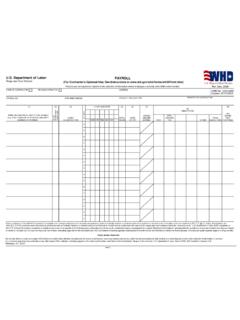Transcription of Defense Primer: Defense Working Capital Funds
1 | 7-5700 March 23, 2018 Defense primer : Defense Working Capital FundsA Department of Defense (DOD) Working Capital fund (DWCF) is a type of revolving fund used to finance operations that function like commercial business activities, ( , equipment maintenance, supply and storage activities, and transporting equipment and people). According to the DOD Financial Management Regulation , revolving fund accounts finance a continuing cycle of business-type operations by incurring obligations and expenditures that generate receipts. DWCFs are used throughout the department in an effort to efficiently provide services or industrial capabilities.
2 Revolving Funds are often considered to have several benefits. First, they operate without fiscal year limitations ( , amounts in a WCF do not expire). Second, they facilitate the aggregation of orders, allowing the government to leverage its purchasing power. Finally, they allow for the establishment of supply inventories that can lead to reduced delivery times. How Do Working Capital Funds Work? When establishing a WCF, Congress typically provides a direct appropriation to the fund (the initial appropriation and positive fund balance is often referred to as a cash corpus).
3 fund managers can use the cash corpus to buy parts and supplies in advance of an anticipated requirement (such as a depot overhaul of an aircraft), or to contract for services (such as commercial air transportation for a deploying military unit). A customer such as an Air Force squadron can then buy the good or service from the WCF-funded organization ( , a depot), using operation and maintenance Funds appropriated to the squadron for that purpose. These WCF transactions move hundreds of billions of dollars within DOD accounts annually.
4 rates In general, DWCFs are expected to be self-sustaining after the initial appropriation. fund managers establish rates charged by the fund , taking into account all costs associated with each anticipated transaction. The rates cover the commodity cost of materials as well as a surcharge, which includes overhead, operating expenses, and administrative requirements. fund managers establish the rates 18-24 months ahead of schedule, and the rates are typically locked in for a specific fiscal year. WCFs are typically organized by budget activity (a category within each fund that identifies the purposes, projects, or types of activities financed by the fund ).
5 In a supply-oriented budget activity, fund managers generally add a surcharge to all items provided in order to cover management and other overhead costs such as warehousing and shipping. Non-supply budget activities (such as those providing maintenance or information technology services) establish surcharge rates based on the unit cost of the service provided plus all overhead costs. fund managers generally budget to recover all operating expenses, including direct costs, such as labor and materials; indirect costs, such as facilities operation and maintenance; hardware costs, such as acquisition and repair of equipment needed to support warehouse operations; operations costs, such as labor, travel, training, transportation of personnel; and other general and administrative costs.
6 Operating and Managing a WCF DWCFs may realize gains or losses within each fiscal year. Gains may be returned to customers by setting lower rates for future fiscal years. Managers can recoup losses by establishing higher rates in later years or seeking additional appropriations from Congress. Regardless, DWCFs must maintain a positive cash balance at all times to avoid Anti-Deficiency Act violations. DOD Financial Management Regulation (FMR) governs DWCFs. The FMR directs DWCFs to operate on a break-even basis (revenue generated equals the cost associated with receiving the revenue).
7 fund managers track and report two main types of operating results in managing a WCF. The net operating result (NOR) is the net difference between expenses and Funds received for a single fiscal year. The accumulated operating result (AOR) is the net difference between expenses and Funds received since the inception of the fund . Managers typically use AOR in establishing the future rates to be charged to customers. History of DOD Working Capital Funds Section 2208 of Title 10 was codified in 1962 and provides the Secretary of Defense the authority to establish a variety of Working Capital Funds to support DOD operations.
8 In 1991, the Secretary of Defense combined five industrial Funds , four stock Funds , and multiple appropriated fund support activities that had been established by the services into the Defense Business Operations fund (DBOF) to streamline management and oversight responsibilities. These operations included depot maintenance, transportation, supply management, and finance and accounting. By 1996, the DOD recognized the difficulty in managing one large WCF and associated challenges in setting rates across the DOD. As a result, the Under Secretary of Defense (Comptroller) disestablished the DBOF in 1997 and established five DWCFs.
9 Defense primer : Defense Working Capital Funds | 7-5700 Air Force Working Capital fund (AFWCF) The AFWCF comprises three activities: two activity groups and the Transportation Working Capital fund (TWCF). The Deputy Assistant Secretary for Budget (SAF/FMB) manages Consolidated Sustainment Activity Group and the Supply Management Activity Group Retail. SAF/FMB is also the Executive Agent for the TWCF, but Transportation Command (TRANSCOM) manages the operations. While TRANSCOM manages the TWCF, its three service component commands (Air Mobility Command, Military Sealift Command, and Military Surface Deployment and Distribution Command) utilize the Funds .
10 TWCF also includes the Defense Courier Division. Navy Working Capital fund (NWCF) The Assistant Secretary of the Navy (Financial Management & Comptroller) manages five activity groups: Depot Maintenance, Base Support, Supply Management, Research and Development (all Naval Warfare Centers and the Naval Research Laboratory), and Transportation. Army Working Capital fund (AWCF) The Assistant Secretary of the Army (Financial Management and Comptroller) manages two activity groups: Industrial Operations and Supply Management. Defense -Wide Working Capital fund (DWWCF) The DWWCF comprises six activity groups managed by three agencies: Defense Logistics Agency (DLA) DLA reports to the Assistant Secretary of Defense (Sustainment) and manages three activity groups: Consumable Supply Management, Energy Management, and Document Automation and Production.

















